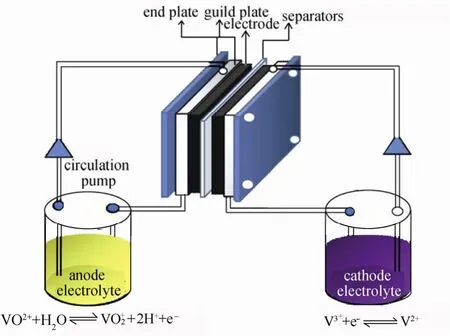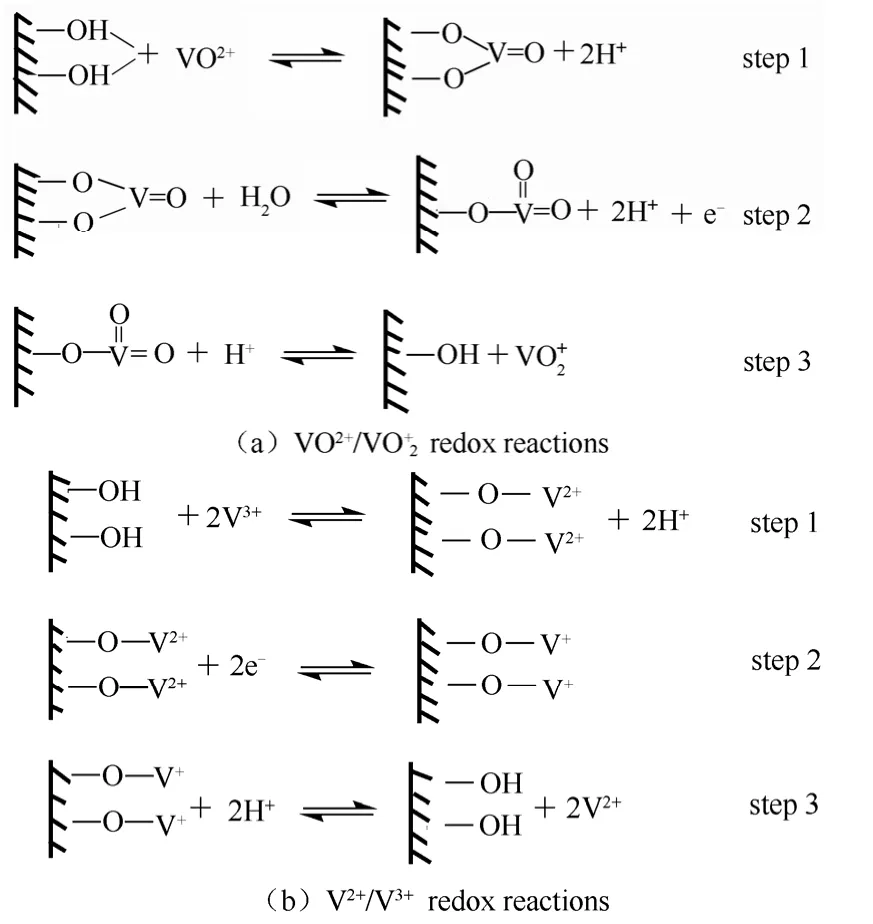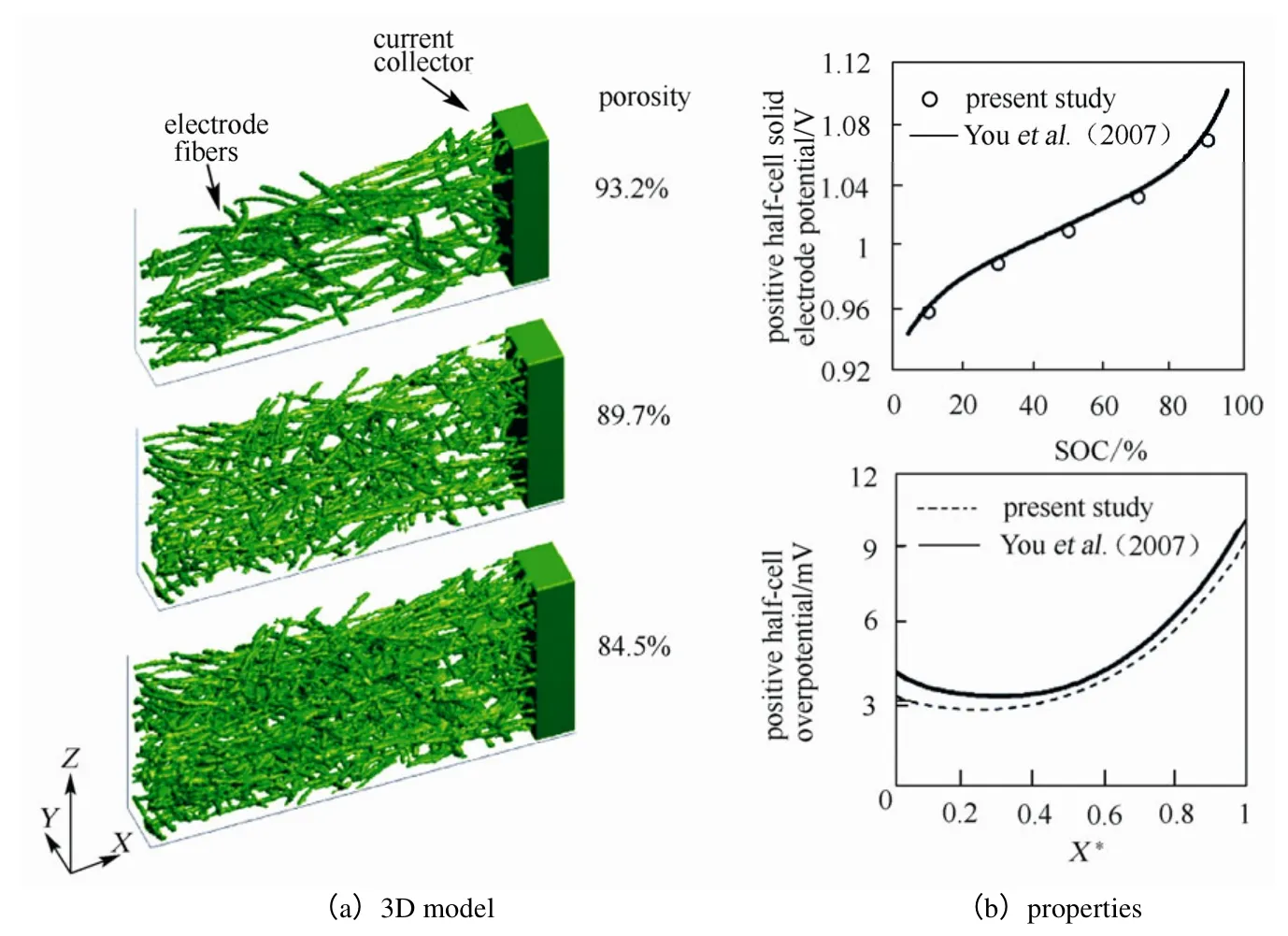全钒液流电池电极材料及其研究进展
李文跃,魏冠杰,刘建国,严川伟
(中国科学院金属研究所,辽宁 沈阳 110016)
钒电池作为一种适合于规模储能的电池技术[1-2], 其单电池主要构造及储能原理如图1所示。钒电池的功率和容量相互独立、适于较大储能规模、充放电及响应快速、循环寿命长等优点受到广泛关注,被认为是最具发展潜力的储能电池技术之一[3]。经过多年的研究与技术实践,已经开始在美国[4]、中 国[5]、日本[6]、加拿大[7]等国家示范应用,主要用于风能、太阳能发电、电网调峰、不间断电源、分布式电站等方面。
电极作为关键材料之一,对电池的整体性能具有重要影响,因而也是制约钒电池进一步产业化发展和应用的一个主要因素。
1 电极材料的性能及要求

图1 钒电池构造及工作原理Fig.1 Illustration of VRFB
电极材料在电池运行过程中,虽然不直接参与钒离子氧化还原电对的转化过程,但其表面作为电化学反应的有效场所,其物理化学性质将对电化学 反应的可逆性及电池性能产生影响。钒电池电极材料除需具有高电化学活性及导电性外,还需要具有优良的化学和电化学稳定性(耐腐蚀、抗强氧化性能)以及一定的力学强度。
2 不同种类电极材料及其性能
钒电池的电极材料大致可以分为如下几类:金属电极;金属氧化物-金属电极;石墨类电极(碳电极)。相应的研究工作主要包括材料筛选、性能评价、电极的活化与改性、电极反应过程及电极相关催化机制等。
2.1 金属电极
金属电极材料由于具有导电性和加工性好等优点,在钒电池发展初期首先受到关注[8]。惰性的铂、金等金属在钒电池工作介质中具有较好的稳定性,但钒离子在其表面的电化学反应可逆性较差,且由于这类材料本身的成本高,因而不具有实用前景和价值。活性金属很难满足全部的作为正极和负极基本的稳定性、导电性及电化学活性等要求,例如,钛作正极由于其表面容易生成影响导电性的较厚钝 化膜,而作为负极则由于其保护性的钝化膜易被还原破坏导致钛基体的腐蚀溶解。所以,除非研究性需要,金属或金属合金材料难以独立地作为电极广泛使用。
2.2 金属氧化物-金属电极
在钛、铅等金属基体上镀上铱、钌等贵金属或通过形成金属氧化物涂层,使其成为完全不同于原金属基体电极行为的新电极,电化学活性可得以大大改善。虽然镀有氧化铱的钛电极表现出较好的电 化学活性和稳定性,但由于析氢过电位低使得其在作为负极使用过程中有较大量的析氢副反应,这将导致电池效率问题[9]。当然,这类电极材料如果用作正极,也存在竞争性的析氧副反应的影响(电池能量效率减小)。但由于具有良好化学和电化学稳定性以及可以承载较大电流密度等突出优点,这类电极在一些特别条件下是不可替代的、不得不选择的正极材料。
2.3 石墨类电极
碳电极材料由于在硫酸溶液中具有良好的导电性、耐蚀性以及较宽的电位窗口等特点,在早期使用金属电极作为钒电池电极的同时,就开始对这类电极材料(包括石墨板、柔性石墨、石墨毡及炭毡等)展开了相关研究。澳大利亚新南威尔士大学的Sum 等[10-11]首先采用循环伏安及旋转圆盘电极等电化学测试方法测定了及V3+/V2+氧化还原电对在玻炭电极表面的电化学反应速率常数的 k0=7 ×10-4cm/s, V3+/V2+的k0=1.2 ×10-4cm/s),并指出电极反应可逆性与电极表面状态密切相关。随后该研究团队在使用石墨电极进行电池性能测试过程中,发现在电池过充时,电极发生的副反应会引起电极的腐蚀破坏[12]。近期,东北大学和中国科学院金属研究所的许茜等[13]对碳电极析氧和析氢的影响规律和相应机制做了进一步的探索:电极表面发生析氧时,电极被氧自由基氧化成二氧化碳或一氧化碳,并在表面被氧化刻蚀(图2)的同时,可能引起析电位的进一步降低,在析氢副反应的影响下,电极表面的结构受到破坏的同时其电化学性能也会受到显著影响[14]。
为了防止石墨电极受到不可逆的损坏,Skyllas-kazacos 等[15]尝试在电极表面涂覆聚苯胺(PANI)防护层,但该防护层的结合性能较差,容易从电极表面剥离。秦春林等[16]考察了耐蚀能力较强的碳硅材料作为电极的可能性。
在实际应用上,钒电池需要具有较大比表面积的电极材料,这样才可以有效降低电池在运行过程中的极化电阻及增加电池的充放电速度等。Skyllas-Kazacos 等[17]考察了炭毡作为电极材料的行为;Zhong 等[18]采用了不同原材料(黏胶基、聚丙烯腈基及沥青基)制备的炭毡材料作为电极,利用电化学的方法评价了不同电极的电化学性能,确认了聚丙烯腈基(PAN)炭毡材料性能较为优异。

图2 石墨电极在2 mol/L VOSO4 + 2 mol/ LH2SO4 溶液中,1.75 V(VS SCE)极化电位下测试不同的时间后的 扫描电镜结果[13]Fig.2 SEM images of graphite electrode polarized at 1.75 V for different times in 2 mol/L VOSO4 + 2 mol/L H2SO4 solution[13]
3 电极性能的影响机制
3.1 表面组成、结构的影响
对炭毡等三维碳电极材料的表面处理方法主要包括:空气中热氧化、电化学氧化、强氧化剂浸泡处理、金属氧化物及其它功能性材料修饰等。Sun 等[19-20]分别将石墨毡在400 ℃空气中热氧化及在浓硫酸中热处理,使石墨毡表面的含氧量显著提高,亲水性明显改善,电池的效率也得到提高。通过分析表面含氧官能团的变化等,提出了催化机理(图3),认为石墨毡表面含氧官能团可以催化钒离子氧化还原电对在电极表面的氧转移及电子转移过程。

图3 石墨毡表面含氧官能团催化VO2+/VO2+及V2+/V3+电对的催化机理[19-20]Fig.3 The catalytic mechanism of oxygen functional groups on the surface of carbon felt towards VO2+/VO2+ and V2+/V3+ couples[19-20]
电化学氧化方法相对于氧化剂浸泡或空气环境热处理相比,可以通过有效控制电解液种类、电极电位等条件参数对最终电极的表面性能进行控 制[21-23],工艺过程更易于操控。其它电极基体表面处理方法包括在芬顿试剂[24]、浓硝酸[25]、浓硫酸热处理[26]及混酸溶液(24HSOV /3HNOV=3/1)水热超声处理[27],在惰性气氛中进行高温热处理[28]及利用等离子体[29]进行电极表面改性等。除在惰性气氛中 进行高温热处理及等离子体处理外,其它的处理方法是以增加电极比表面积及表面含氧官能团为出发点来提高电极的电化学活性。炭毡电极材料在惰性气氛中热处理后,表面的杂质含量明显降低,使更多的电极表面暴露出来,尤其是2000 ℃以上高温热处理后,炭毡材料的石墨化度有了明显的提高,材料电阻明显减小,但在处理过程中,炭毡表面的含氧量显著减低(例如,将炭毡材料在2200 ℃处理1 h 后,含氧量由15.6%降低到3.8%)。如果稳定控制在1600 ℃以下,既能使炭毡的性能得到改善,又可使电极表面的含氧量、电阻及电极表面积之间的平衡,获得较好的综合处理结果[28]。
3.2 催化剂及催化性能
钒电池用催化剂的研究探索主要集中在金属、过渡金属氧化物及以碳纳米管(CNTs)为代表的功能材料。Sun 等[30]采用离子交换方法使电化学氧化后的碳纤维表面分别吸附上金属离子,发现一些金属材料修饰后的电极对VO2+/VO2+有较显著的催化作用。由于氢在金、铂及钯金属的析氢过电位较低,以这些金属离子处理将导致电极析氢副反应增多。Santamaría 等[31]采用元素铋修饰炭毡表面,得到了明显的正极催化效果。对于钒电池用过渡金属氧化物的研究,主要有氧化铱[32]和四氧化三锰(图4)[33]。虽然这些材料可以明显催化钒离子的氧化还原过程,但在电池运行过程中的长时间稳定性还有待进一步考察。

图4 Mn3O4 颗粒修饰炭毡材料的扫描电镜及循环伏安曲线[33]Fig.4 SEM images of carbon felts modified with Mn3O4 particles and CV curves[33]
Zhu 等[34]利用CNTs 具有的比表面积大、电导率高、在酸性溶液中好的稳定性及可修饰性特性, 将其掺杂到石墨粉体中,得到了性能优化的CNTs增强石墨电极。中国科学院金属研究所研究人员[35]用Hummers 法制备氧化石墨并控制其加入量,得到了电化学性能明显改善的氧化石墨/石墨复合电极,并将其电极性能的提高归因于氧化石墨大的比表面积及丰富的含氧官能团(图5)。Pan 等[36-37]研究了氧化石墨烯电催化活性。Blanco 等[38]通过在惰性气氛中处理GO 得到了热还原的氧化石墨烯 (TRGO)材料,并对比研究了TRGO 的催化活性。由于处理使材料的比表面积及电导性增加的同时保留了一定数量的含氧官能团,结果GO 具有显著的催化活性。Yan 等[39-40]对不同的多壁CNTs(普通、羧基化及羟基化CNTs 三种)的催化性能进行了对比研究,发现虽然羟基化的CNTs 比表面积最大,但羧基化的CNTs 的性能要明显优于前者,以此认为电极表面的羧基官能团在电极反应中起到了更关键的作用。
将具有催化能力的物质固定到电极表面是一个明显的难题。Wang 等[41-42]采用气相化学沉积(CVD) 的方式分别将碳纤维和CNTs 沉积到炭毡纤维表面。Liu 等[43]采用Nafion 为黏结剂将CNTs 固定在炭毡的表面(图6),使电池效率有了明显的提高,但Nafion 材料能否经受住长时间的冲刷保证CNTs不脱落,还需要进一步考核。Mench 等[44]通过制备CNTs 催化层将CNTs 固定在电极的表面。
关于电极中引入氮元素等元素的功能性影响,Shao 等[42,45-46]研究了氮原子引入对电极材料催化性能的影响,发现经过氮掺杂的介孔炭作为正极材料,钒离子在电极表面的氧化还原可逆性得到明显 提高。
3.3 电极结构与一体化电极

图5 提出的氧化石墨催化VO2+/VO2+及V3+/V2+电对的机理[35]Fig.5 The catalytic mechanism of GO materials towards VO2+/VO2+and V3+/V2+[35]

图6 炭毡/nafion/CNTs 复合电极的扫描电镜图片及电池充放电曲线[43]Fig.6 SEM images of carbon felts/nafion/CNTs composite electrode and charge-discharge curves for pristine and modified carbon felts[43]
一般地,将作为电极材料的石墨毡与集流双极板通过机械压合方式组合装配,电极与集流板之间存在明显的接触电阻,并且在一定条件下该接触电 阻值取决于装配电池的压紧力大小。然而,过大的压紧力将使得石墨毡电极的孔隙率减小,造成电解液传质阻力增大,引起较大的浓差极化。为了降低电极和集流板之间的接触电阻,并保证液流传质等,一体化电极的设计[47-48]成为一个研究热点。所谓一体化电极,就是采用适当方式将石墨毡电极结合在具有良好导电性的集流板上成为一个整体电极的操作。Zhang 等[48]在石墨毡和柔性石墨板间加入一层碳素复合薄层,然后将三者热压在一起组成一体化电极。与传统工艺相比,这种一体化电极的制备成本降低了10%,而导电性提高了40%。由该一体化电极组装的电池能量效率从传统工艺的73%提高到81%。一体化电极不仅可有效提高电池性能和可靠性,而且可简化电池的装配流程。
Sun 等[49]采用三维孔尺度传递分析模型,计算了电极材料孔结构改变对电池性能的影响(图7)。 以此模型预测的结果之一是:适当低的孔隙度、较高比表面积的电极材料能够形成更均匀一致的流场和电场,并可使电池的工作电流密度降低。
4 结 语
尽管人们已经对碳材料作为钒电池电极材料进行了较广泛的考察研究,所取得结果对钒电池的技术发展发挥了重要的作用,但距离构建起能够满足钒电池进一步产业化发展需要的知识体系尚有很长的路要走。如下方面可能是今后一段时间需要重点予以关注的研究内容:① 以满足钒电池产业需求为目标的石墨毡电极批量化、规模化生产制造工艺技术;② 能够满足钒电池新结构发展的实用化新型电极材料技术;③ 电极系统及其与电池结构在工作条件下的优化配合;④ 电极的使役行为、退化机制及其控制技术与策略。

图7 用于电极孔尺寸模拟的模型[49]Fig.7 3D model used in the pore scale simulation[49]
[1] Skyllas-Kazacos M,Rychcik M,Robins R G,et al. New all vanadium redox cell[J]. Journal of Electrochemical Society,1986,133(5):1057-1058.
[2] Rychcik M,Skyllas-Kazacos M. Characteristics of new all vanadium redox flow battery[J]. Journal of Power Sources,1988,22(1):59-67.
[3] Ponce de León C,Frías-Ferrer A,González-García J,et al. Redox flow cells for energy conversion[J]. Journal of Power Sources,2006,160(1): 716-732.
[4] Jia Zhijun(贾志军),Song Shiqiang(宋士强),Wang Baoguo(王保国). Acritical review on redox flow batteries for electrical energy storage applications[J]. Energy Storage Science and Technology(储能科学与技术),2012,1(1):50-57.
[5] Zhao P,Zhang H,Zhou H,et al. Characteristics and performance of 10 kW class all vanadium redox flow battery stack[J]. Journal of Power Sources,2006,16(2):1416-1420.
[6] Tokuda N,Kumamoto T,Shigematsu T,et al. Development of a redox flow battery system[J]. SEI Technical Review,1998,45:103-107.
[7] Cui Xumei(崔旭梅),Wang Jun(王军),Chen Xiaoe(陈孝娥),et al. Progress in the electrode material of vanadium redox flow battery[J]. New Chemical Materials(化工新型材料),2008,36(7):17-19.
[8] Skyllas-Kazaoes M,Rychcik M. Evaluation of electrode materials for all vanadium redox flow cell[J]. Journal of Power Sources,1987,19(1): 45-54.
[9] Qian Peng(钱鹏),Zhang Huamin(张华民),Chen Jian(陈剑),et al. Progress on electrode and bipolar plate materials for vanadium redox flow batteries[J]. Energy Engineering(能源工程),2007(1):7-11.
[10] Sun E,Skyllas-Kazacos M. A study of the V2+/V3+redox couple for flow cell applications[J]. Journal of Power Sources,1985,15(2-3):179-190.
[11] Sun E,Rychcik M,Skyllas-Kazacos M. Investigation of V4+/V5+system for use in positive half-cell of a redox battery[J]. Journal of Power Sources,1985,16(2):85-95.
[12] Skyllas-Kazacos M,Rychcik M,Robinsrg,et al. New-all vanadium redox cell[J]. Journal of Electrochemical Society,1986,133(5):1057-1058.
[13] Liu H,Xu Q,Yan C,et al. Corrosion behavior of a positive graphite electrode in vanadium redox flow battery[J]. Electrochimica Acta,2011,56(24):8783-8790.
[14] Chen F,Liu J,Chen H,et al. Study on hydrogen evolution reaction at a graphite electrode in the all-vanadium redox flow battery[J]. International Journal of Electrochemical Science,2012,7(4):3750-3764.
[15] Haddadi-Asl V,Kazacos M,Skyllas-Kazacos M. Conductive carbon polypropylene composite electrodes for vanadium redox flow battery[J]. Applied Electrochemisty,1995,25(1):29-33.
[16] Yuan Yanling(袁燕岭),Xu Yun(徐云),Qin Chunlin(秦春林). Design and primary study of vanadium battery with carbon-silicon rod as electrodes[J]. Chinese Journal of Power Sources(电源技术),2007,31(11):910-913.
[17] Kazacos M,Skyllas-Kazacos M. Performance of carbon plastic electrodes in vanadium redox cell[J]. Journal of Electrochemical Society,1989,136(9):2759-2760.
[18] Zhong S,Padeste C,Kazacosm,et al. Comparison of the physical,chemical and electrochemical properties of rayon-and poly-acylonitrile-based graphite felt electrodes[J]. Journal of Power Sources,1993,45(1):29-41.
[19] Sun B, Skyllas-Kazacos M. Modification of graphite electrode materials for vanadium redox flow battery application-I. Thermal treatment[J].Electrochimica Acta,1992,37(7):1253-1260.
[20] Sun B,Skyllas-Kazacos M. Chemical modification of graphite electrode materials for vanadium redox flow battery application-part II. Acid treatments[J]. Electrochimica Acta,1992,37(13):2459-65.
[21] Liu Suqin(刘素琴),Zhang Wenxi(张文昔),Huang Kelong(黄可龙). Study on the electrochemical properties of carbon felt modified by PB and oxalic acid VRB application[J]. Chinese Journal of Power Sources(电源技术),2006,30(5):395- 397.
[22] Li Hua(李华),Yan Chuanwei(严川伟),Tian Bo(田波). Electrocatalysis of Prussian Blue for V5+/V4+in vanadium redox cell[J]. Chinese Journal of Power Sources(电源技术),2004,28(3):167-169.
[23] Men Y,Sun T. Carbon felts electrode treated in different weak acid solutions through electrochemical oxidation method for all vanadium redox flow battery[J]. International Journal of Electrochemical Science,2012,7(4):3482-3488.
[24] Gao C,Wang N,Peng S,et al. Influence of Fenton’s reagent treatment on electrochemical properties of graphite felt for all vanadium redox flow battery[J]. Electrochimica Acta,2010. doi:10.1016/j.electacta.2012.10.021.
[25] Li X,Huang K,Liu S,et al. Characteristics of graphite felt electrode electrochemically oxidized for vanadium redox battery application[J]. Transactions of Nonferrous Metals Society of China,2007,17(1):195-199.
[26] Li Xiaogang(李晓刚),Huang Kelong(黄可龙),Sang Shangbin(桑商斌),et al. Catalysis of graphite felt electrode treated with electrochemical oxidation for VO2+/VO2+[J]. Journal of Functional Materials(功能材料),2006,37(7):1084-1086.
[27] Yue L,Li W,Sun F,et al. Highly hydroxylated carbon fibres as electrode materials of all-vanadium redox flow battery[J]. Carbon,2010,48 (11): 3079-3090.
[28] Li W,Liu J,Yan C. Modified carbon felts used as positive electrode for all vanadium redox flow battery[C]//The 7th International Green Energy Conference & The 1st DNL Conference on Clean Energy,2012,Dalian,China.
[29] Kim K,Kim Y,Kim J,et al. The effects of surface modification on carbon felt electrodes for use in vanadium redox flow batteries[J]. Materials Chemistry and Physics,2011,131(1-2):547-53.
[30] Sun B,Skyllas-Kazacos M. Chemical modification and electrochemical behavior of graphite fiber in acidic vanadium solution[J]. Electrochimica Acta,1991,36(3/4):513-517.
[31] González Z,Sánchez A,Blanco C,et al. Enhanced performance of a Bi-modified graphite felt as the positive electrode of a vanadium redox flow battery[J]. Electrochemistry Communications,2011,13(12):1379-1382.
[32] Wang W,Wang X. Investigation of Ir-modified carbon felts as the positive electrode of an all-vanadium redox flow battery[J]. Electrochimica Acta,2007,52 (24):6755-6762.
[33] Kim K,Park M,Kim J,et al. Novel catalytic effects of Mn3O4for all vanadium redox flow batteries[J]. Chemical Communication,2012,48:5455-5457.
[34] Zhu H,Zhang Y,Yue L,et al. Graphite-carbon nanotube composite electrodes for all vanadium redox flow batter[J]. Journal of Power Sources,2008,184(2):637-640.
[35] Li W,Liu J,Yan C. Graphite-graphite oxide composite electrode for vanadium redox flow battery[J]. Electrochimica Acta,2011,56(14):5290-5294.
[36] Han P,Wang H,Liu Z,et al. Graphene oxide nanoplatelets as excellent electrochemical active materials for VO2+/VO2+and V2+/V3+redox couples for a vanadium redox flow battery[J]. Carbon,2011,49(2):693-700.
[37] Han P,Yue Y,Liu Z,et al. Graphene oxide nanosheets/multi-walled carbon nanotubes hybrid as an excellent electrocatalytic material towards VO2+/VO2+redox couples for vanadium redox flow batteries[J]. Energy Environment & Science,2011,4:4710-4717.
[38] González Z,Botas C,Álvarez P,et al. Thermally reduced graphite oxide as positive electrode in vanadium redox flow batteries[J]. Carbon,2012,50(3):828-834.
[39] Li W,Liu J,Yan C. Multi-walled carbon nanotubes used as an electrode reaction catalyst for VO2+/VO2+for a vanadium redox flow battery[J]. Carbon,2011,49(11):3463-3470.
[40] Li W,Liu J,Yan C. The electrochemical catalytic activity of single-walled carbon nanotubes towards VO2+/VO2+and V3+/V2+redox pairs for an all vanadium redox flow battery[J]. Electrochimica Acta,2012,79:102-106.
[41] Yang H,Hung C,Wang S. Graphite felt with vapor grown carbon fibers as electrodes for vanadium redox flow batteries[J]. Rare Metal,2011,30(sl):1-4.
[42] Wang S,Zhao X,Cochell T,et al. Nitrogen-doped carbon nanotube/graphite felts as advanced electrode materials for vanadium redox flow batteries[J]. The Journal of Physical Chemistry Letters,2012,3:2164-2167.
[43] Wei G,Jia C,Liu J,et al. Carbon felt supported carbon nanotubes catalysts composite electrode for vanadium redox flow battery application[J]. Journal of Power Sources,2012,220:185-192.
[44] Manahan M,Liu Q,Gross M,et al. Carbon nanoporous layer for reaction location management and performance enhancement in all-vanadium redox flow batteries[J]. Journal of Power Sources,2013,222:498-502.
[45] Shao Y,Wang X,Engelhard M,et al. Nitrogen-doped mesoporous carbon for energy storage in vanadium redox flow batteries[J]. Journal of Power Sources,2010,195(13):4375-4379.
[46] Wu T,Huang K,Liu S,et al. Hydrothermal ammoniated treatment of PAN-graphite felt for vanadium redox flow battery[J]. Journal of Solid State Electrochemistry,2012,16(2):579-585.
[47] Xu Qian(许茜),Feng Shichao(冯士超),Qiao Yonglian(乔永莲),et al. Study on behavior of the carbon-polythene composite current collector for vanadium battery[J]. Chinese Journal of Power Sources(电源技术),2007,31(5):406-408.
[48] Qian P,Zhang H,Chen J,et al. A novel electrode bipolar plate assembly for vanadium redox flow battery applications[J]. Journal Power Sources,2008,175(1):613-620.
[49] Qiu G,Dennison C,Knehr K,et al. Pore-scale analysis of effects of electrode morphology and electrolyte flow conditions on performance of vanadium redox flow batteries[J]. Journal of Power Sources,2012,219:223-234.

